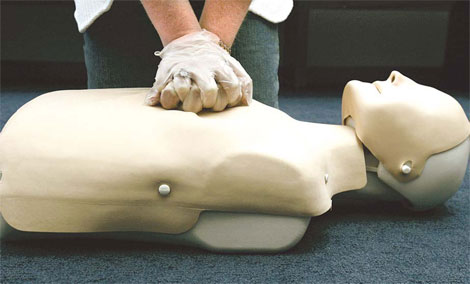Life and Leisure
Straight to the heart
(China Daily)
Updated: 2010-10-20 08:22
 |
Large Medium Small |
|
A new study finds bystanders saved more lives using hands-only CPR than those using traditional CPR with mouth-to-mouth breathing. Haraz N. Ghanbari / Associated Press |
Roll up your sleeves and start pumping the chest. That's the latest advice on what to do if you see someone collapse from sudden cardiac arrest
After 50 years of loyal service, traditional CPR is being replaced by a new, bare-bones version of the life-saving emergency procedure.
Forget about yucky mouth-to-mouth contact - the P in cardiopulmonary resuscitation (CPR) - and get right down to pumping hard and fast on the chest, the American Heart Association said on Monday.
That will keep oxygen-rich blood flowing to the brain until trained rescuers can take over.
"Chest compressions are the most important part of CPR," says Dr Michael Sayre, a spokesman for association. "The major change is switching to starting CPR with chest compressions rather than opening an airway and doing rescue breathing."
Only if a rescuer has been specifically trained in conventional CPR should they give rescue breathing, adds Sayre, also of Ohio State University in Columbus.
Recent studies have shown that CPR without rescue breathing works as well as or better than the full version in most people who suffer cardiac arrest.
And it might also get more people to do CPR, which is currently performed only about half the time when someone witnesses a person collapsing from cardiac arrest.
That dismal number hasn't changed in three decades. But doctors say it could, and part of the solution is to get more bystanders to roll up their sleeves and start chest compressions in the center of the chest.
The ideal rate is at least 100 compressions per minute - coincidentally, about the same pace as the Bee Gees 1977 disco hit Stayin' Alive. Each compression should be about 5 cm deep in adults and children, and about 3.8 cm in infants. Rescuers should not lean on the chest between compressions; it's important to let the chest return to its starting position.
"If you see the victim suddenly collapse - one minute they're walking and talking and the next minute they are on the ground - then the odds are high that it is cardiac arrest," Sayre says.
If the victim is not breathing or not breathing normally, "Tap on their shoulder to see if you can wake them up. If you can't, then we recommend starting chest compressions after calling 911."
If you start CPR on someone who collapsed for some reason other than a cardiac arrest, "they usually just wake up", Sayre says, adding that serious injuries are rare.
Earlier this month, Arizona saw the effects of a state-wide campaign to get bystanders to do hands-only CPR.
Five years after health officials started promoting the technique, the chances of surviving a cardiac arrest had more than doubled, reaching close to 10 percent. And those victims who received hands-only CPR had more than 1.5 times the odds of making it compared to those who got conventional CPR.
"I don't see any reason why in the future you wouldn't have a better chance of surviving than dying of a cardiac arrest," Dr Bentley J. Bobrow, of Arizona's Bureau of Emergency Medical Services and Trauma System, says.
He notes, however, that factors such as public-access defibrillators - which can jolt the heart back to its normal rhythm - and better hospital care are also important.
For people who are trained in conventional CPR, the new guidelines recommend giving two breaths after 30 compressions, and then repeating the cycle.
That may be especially helpful for many children and people who have drowned, because their blood is out of oxygen. But for the majority of adults with cardiac arrest, the heart gives in suddenly because the arteries that supply it with blood get clogged by cholesterol. For those people, keeping the blood flowing without interruption appears to be vital.
The American Heart Association has created a short Web tutorial that shows how to do effective CPR. It's available at http://handsonlycpr.org/.
Reuters
